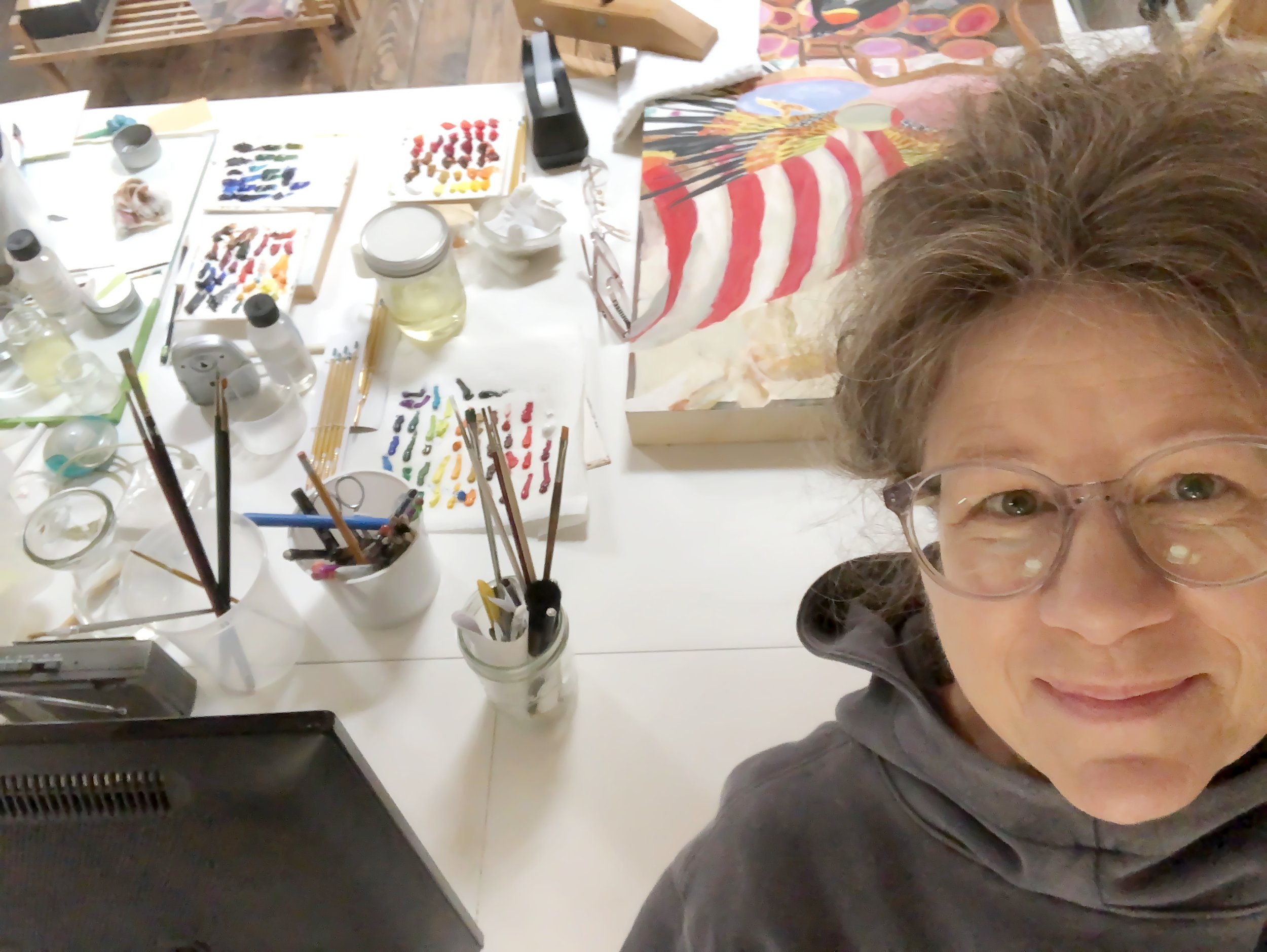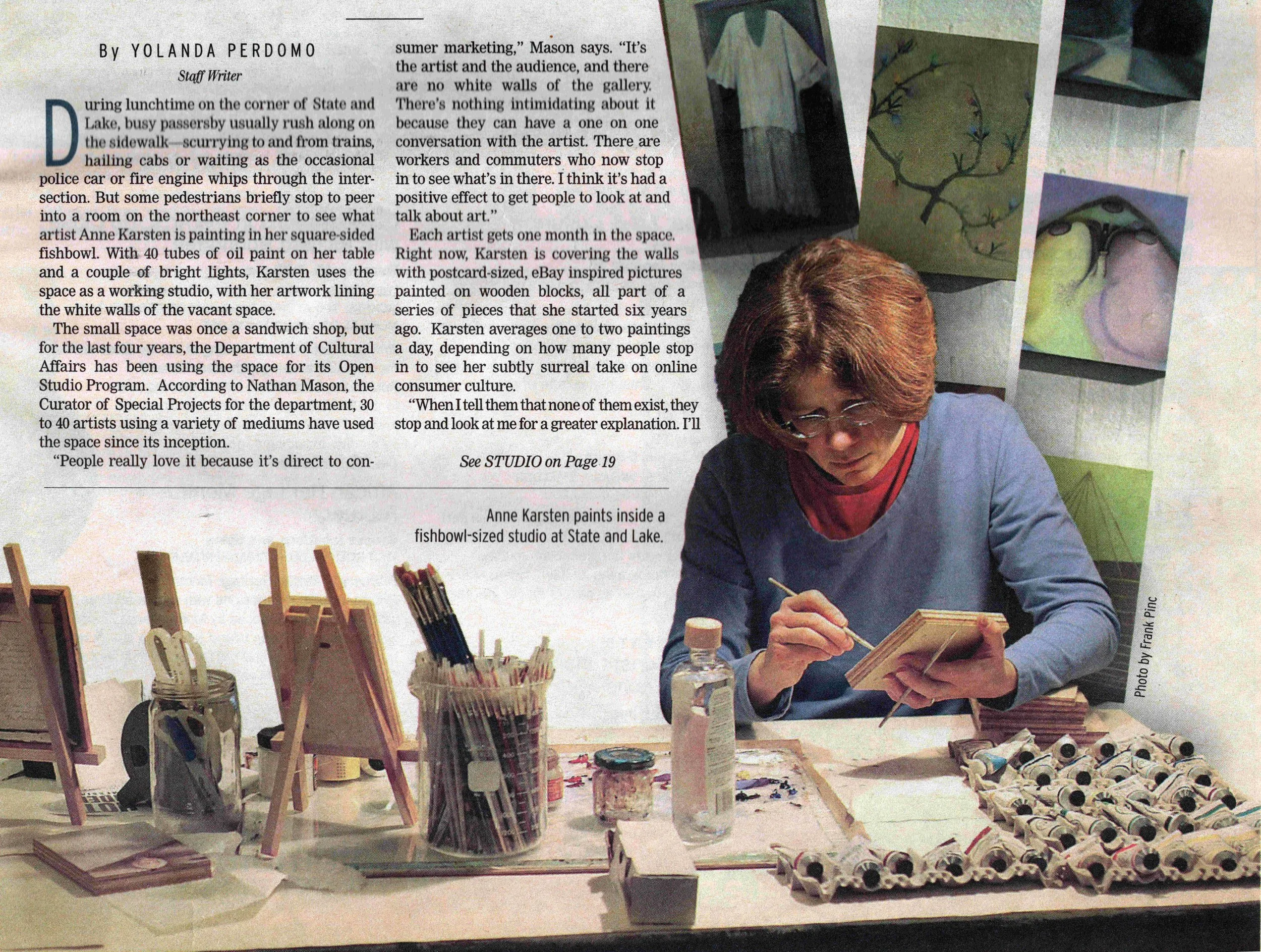About
June 2023, Chicago IL
Statement
People in consumer based cultures create meaning for ourselves through our attachments and interactions with our possessions. Through depicting these possessions in dreamlike ways, I reflect undercurrents in human behavior and awareness as they point to the development of human consciousness, and investigate how this changes the stories we tell ourselves.
Ground
My mother exhibited great care for all objects in her possession at all times, regardless of monetary value. There was never a junk drawer. With this she demonstrated an idea of an equanimity that forestalled a certain type of labeling, in that everything that came into her possession was seen, considered, and the scope of its usefulness acknowledged. Everything she kept was purposeful, but everything she chose was quietly beautiful. Born in an era where planned obsolescence was unthinkable, she was keenly aware of how the idea of disposability accelerated over the course of her lifetime. For me, this recognition begins it all- the fall from grace is simply an agreement to garbage.
Resume/CV
There are lots of interesting things you can do in art and I’m lucky to have done a few of them. Some are listed here.
AI
AI never writes for me, nor does anyone else. If I ever use AI in a published work, I’ll acknowledge it openly.
I have thoughts on consensus-based artmaking, which happens in some form anytime we look outward for answers or legitimacy; it’s a different sensibility than a zeitgeist. From my perspective, consensus-based artmaking seems to be what a segment of the art world has relied on to prop up its relevance. It’s not wrong. But AI imagery, like most outcomes based in accommodating popular taste, seems to stop short of what it might have been, or to put it another way, it doesn’t know what it wants to say, but is in agreement to what has already been said.
Working on Seraph, 2023 || Image developed through feeding an unfinished drawing to DALL-E then redrawing the returns digitally as a preliminary sketch for the painting
PRESS
This article about the eBay Painting Series was written by Yolanda Perdomo and published in the Chicago Journal, Thursday, January 18, 2007, Volume 7, No. 9.
Metropolis
Artists at work
Loop studio is a voyeur’s dream come true
By Yolanda Perdomo
Staff writer
During lunchtime on the corner of State and Lake, busy passersby usually rush along on the sidewalk — scurrying to and from trains, hailing cabs or waiting as the occasional police car or fire engine whips through the intersection. But some pedestrians briefly stop to peer into a room on the northeast corner to see what artist Anne Karsten is painting in her square sided fishbowl. With 40 tubes of oil paint on her table and a couple of bright lights, Karsten uses the space as a working studio, with her artwork lining the white walls of the vacant space.
The small space was once a sandwich shop, but for the last four years, the Department of Cultural Affairs has been using the space for its Open Studio Program. According to Nathan Mason, the Curator of Special Projects for the department, 30 to 40 artists using a variety of mediums have used the space since its inception.
“People really love it because it’s direct to consumer marketing,“ Mason says. “It’s the artist and the audience, and there are no white walls of the gallery. There’s nothing intimidating about it because they can have a one on one conversation with the artist. There are workers and commuters who now stop in to see what’s in there. I think it’s had a positive effect to get people to look at and talk about art.“
Each artist gets one month in the space. Right now, Karsten is covering the walls with postcard sized, eBay inspired pictures painted on wooden blocks, all part of a series of pieces that she started six years ago. Karsten averages one to two paintings a day, depending on how many people stop in to see her subtly surreal take on online consumer culture.
“When I told them that none of them exist, they stop and look at me for a greater explanation. I’ll say that they’re fictionalized objects that were for sale on eBay,“ says Karsten, points to a picture of a beige chain purse with 12 kiss lock closures, and discusses another painting with a wrinkled finger, showing off a stunning ring. “I wanted to comment on the vanity aspect of decorating yourself with jewelry. It’s lovely and may make you feel more beautiful, when you actually look at it; you have a wrinkly finger with a beautiful item. But it’s just an item.“
Karsten, who paints in the space Monday through Friday, has enjoyed working in a busy environment. That’s quite different from working in her usual workplace. Once the paintings are finished, Karsten hangs them on nails on the wall, where people are encouraged to come up with their own interpretations of the artwork.
“They could come in and move the paintings around, and tell stories about the paintings if they wanted to rearrange them to tell a story,“ says Karsten who estimates that anywhere from 20 to 40 people stop in on any given day. “It’s another way to internalize another experience with art. You come in here and you look at it and have that memory in your eye for the rest of your life. I suppose by selecting something, and arranging something, you’ve made it more personal.“
Even though the program in the busy location has been deemed a success, the artists may no longer have that prime real estate. According to Mason, the city currently has the property for sale, and the studio may only operate through the month of March. After that, the program will move to the Chicago Cultural Center, 77 E. Washington St., where it will reside in the pedway in the northeast corner of the building. But Mason adds that the plans for the sale may change. “It has changed several times. We only thought it would be here (on State and Lake) for one year when we began.“
Karsten, meanwhile, will make away for another artist starting January 31, per the guidelines of the program. She says she’s applied to show her work in the surrounding suburbs in Indiana, but will nonetheless miss working on a glass walled downtown space.
“I’m really grateful to have had this opportunity to show in a place where people are free to come in and see me working and ask me whatever questions they have,” as Karsten, who will pack up whatever unsold paintings she has and put some up on her kitchen wall. “People are merely curious coming in. They may not have any real background an art, but they come in and say, ‘what is this?’ It’s been lovely.”


